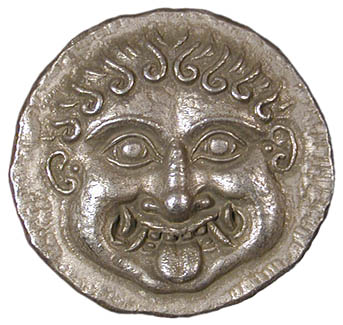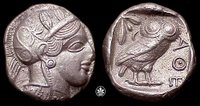The drachma is a coin with the value of six obols. The term drachma means “handful”—in other words, it was a considered to be a handful of obols. Various denominations of the drachma were made—the octadrachm, tetradrachm, didrachm, and drachm among them.
This coin, like the obol, first appeared in Aegina after 600 BCE, but quickly spread to other regions of Greece. One of which was Athens, notable for its significant wealth and the volume of coins which have been recovered and studied.
The earliest series of coins in Athens were the Wappenmunzen. Most of the Wappenmunzen were didrachm, which weighed about eight and one-half grams. These coins had a variety of types on the obverse and an imprint on the reverse. The possible obverse stamps includes owls, horse protomes, amphoras, horse’s hindquarters, wheels, bettles, Gorgons, bull’s heads, astragalos, and triskelis. Eventually, the didrachm became far less common than the tetradrachm. This is attributed to a shift from internal use, which would require smaller denominations to be used on a day-to-day basis, to use for foreign trade, which would require larger denominations to purchase greater quantities of goods.
Below: Athenian Wappenmunzen featuring a Gorgon
(http://rg.ancients.info/slavey/)

While Athenian tetradrachm in the archaic period varied greatly, it remained largely the same between the fifth and third centuries. All tetradrachma during this time featured Athena wearing a diadem of olive leaves on the obverse and an owl on the reverse, with a small lunar crescent behind it. Minor details that changed included four small olive leaves added to Athena’s helmet around 475 BCE which eventually was to become only three leaves. Additionally, Athena’s head became larger through time, and small changes were made in the posture of the owl (from upright to diagonal) and the sprig of olive (a berry sandwiched between two leaves at right angles).
Below: An Athenian tetradrachma
(http://www.answers.com/topic/age-of-pericles)

A major change in Athens’s drachma occurred as a result of the great cost of the Peloponnesian war. The local sources of silver, which had once been extremely plentiful, were depleted. The standard of currency then had to be shifted from silver to gold in order to produce enough money to finance the war. One gold drachma weighed the same as a silver drachma, but had twelve times the value. Because of its high value, gold was impractical for small daily transactions, however. This was a major factor in the introduction of bronze coins for smaller denominations which were more useful for internal trade.
Sources:
Jenkins, G.K. Ancient Greek Coins (New York: G.P. Putnam's Sons, 1972).
Kraay, Colin M. Archaic and Classical Greek Coins (London: Methuen and Co. LTD, 1976).
Posted at Dec 11/2007 10:20PM:
keffie: Nice work. I really like that you picked a theme of interest to you and explored it more in depth.
Posted at Dec 13/2007 11:34PM:
Harry Anastopulos: Especially considering that this was a topic that we didn't get to cover in as much depth during class time, this was a very interesting glossary entry! What a shame that the Euro has now replaced the drachma's most recent incarnation...
